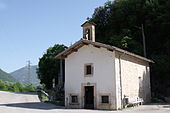Scheggino
| Scheggino | ||
|---|---|---|

|
|
|
| Country | Italy | |
| region | Umbria | |
| province | Perugia (PG) | |
| Coordinates | 42 ° 43 ′ N , 12 ° 50 ′ E | |
| height | 282 m slm | |
| surface | 35.17 km² | |
| Residents | 464 (Dec. 31, 2019) | |
| Population density | 13 inhabitants / km² | |
| Post Code | 06040 | |
| prefix | 0743 | |
| ISTAT number | 054047 | |
| Popular name | Schegginesi | |
| Patron saint | San Nicola (December 6th) | |
| Website | Scheggino municipality | |
 Panorama of Scheggino |
||
Scheggino is an Italian commune with 464 inhabitants (as of December 31, 2019) in the province of Perugia in the Umbria region .
geography
The community extends over around 35 km² . The municipality is located about 65 km southeast of Perugia on the Nera River and thus in the Nera Valley. The municipality is in the climatic classification of Italian municipalities in zone D, 2076 GR / G.
The districts (Frazioni), which are all south of the main town along the Nera and were created to protect the Abbazia di San Pietro abbey in Valle (today the municipality of Ferentillo ), are Ceselli, Civitella, Collefabbri, Monte San Vito, Nevi, Pontuglia, San Valentino and Schioppo.
The neighboring municipalities are Ferentillo ( TR ), Monteleone di Spoleto , Sant'Anatolia di Narco and Spoleto .
history
The first name of the castle was Schiaginum , after which it was called Schezzino . The current name emerged from the 18th century. The castle or the community was allied with Spoleto until 1561, which led to sieges and destruction in 1391 and 1522 (by Picozzo Brancaleoni), after which it gave itself its own statutes. The place itself was created in the 16th century when houses were being built below the castle. The district of Civitella became part of the municipality in 1895, as did Monte San Vito, which was first a separate municipality and later belonged to Sant'Anatolia di Narco. After the unification of Italy , the population remained constant at approx. 900 inhabitants, since 1950 the place has experienced a population decline that is currently around half.
Attractions
- Chiesa di Giovanni Evangelista , church from the 14th century in the district of Civitella
- Chiesa di San Michele Arcangelo , church from the 14th century in the district of Ceselli
- Chiesa di San Michele Arcangelo , 13th century church in the Monte San Vito district
- Chiesa di San Nicolò , church in the main town from the 13th century, renovated and remodeled in the 16th century. Contains the frescoes of the Nativity of Christ and the Coronation of Mary (1526) by Lo Spagna with his assistant Giovanni di Girolamo and the painting Madonna col Bambino ei santi Giacomo, Rocco, Giovanni Evangelista, Sebastiano e un papa martire by Guido Ubaldo Abbatini
- Chiesa di San Rocco , church near the Nera in the main town
- Chiesa di San Sebastiano , 15th century church in the Ceselli district
- Chiesa di Santo Stefano , main church in the Collefabri district from the 15th century
- Chiesa di San Valentino , church from the 13th century in the district of San Valentino, contains several works by Maestro di Eggi
- Palazzo Graziani , 18th century building in the main town
literature
- TCI : Umbria , Milan 1999, p. 455, ISBN 88-365-2542-3
Web links
- Official website of the municipality of Scheggino (Italian)
- Data and information on Scheggino at Comuni Italiani (Italian)
Individual evidence
- ↑ Statistiche demografiche ISTAT. Monthly population statistics of the Istituto Nazionale di Statistica , as of December 31 of 2019.
- ↑ La mia Umbria website, accessed May 24, 2011
- ↑ BIM Cascia website, accessed on May 24, 2011



